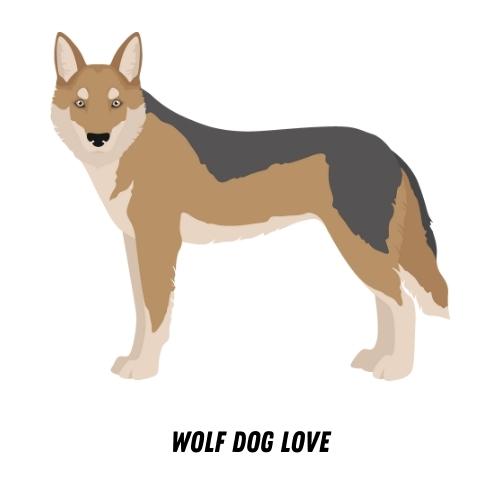Introduction to Wolf Dog Genetics
Wolf dogs, as the name suggests, are a mix of wolves and domestic dogs. They are fascinating creatures, and their genetics are equally intriguing. In this blog post, we will delve into the fascinating world of wolf dog genetics. We will start by understanding the basics of canine genetics and then move on to the importance of studying wolf dog genetics.
- Understanding the Basics of Canine Genetics
- Importance of Studying Wolf Dog Genetics
Canine genetics is the study of how traits and diseases are passed down from parents to offspring in dogs. Just like humans, dogs have chromosomes that carry genes. These genes determine everything from the color of a dog’s fur to its likelihood of developing certain diseases.
Each dog has 39 pairs of chromosomes, making a total of 78. These chromosomes carry about 20,000 to 25,000 genes. These genes are like instructions that tell the dog’s body how to grow and function.
When a puppy is conceived, it gets one set of 39 chromosomes from its mother and another set from its father. This mix of genes is what makes each dog unique.
Studying wolf dog genetics is important for several reasons. Firstly, it helps us understand the health and behavior of wolf dogs better. For instance, some wolf dogs may be prone to certain health conditions due to their genetic makeup. By studying their genetics, we can identify these risks and take steps to manage them.
Secondly, wolf dog genetics can also give us insights into the evolution of dogs. By comparing the genes of wolf dogs with those of wolves and other dogs, we can learn more about how dogs have evolved over time.
Finally, studying wolf dog genetics can help in conservation efforts. Wolves are endangered in many parts of the world, and understanding their genetics can help in their preservation.
Wolf Dog Genetic Variability
Wolf dogs, a unique blend of wolf and domestic dog, exhibit a fascinating range of genetic variability. This diversity is a result of several key factors that we will explore in this section.
Factors Contributing to Genetic Variability
Three primary factors contribute to the genetic variability seen in wolf dogs: breeding practices, natural selection, and mutation. Let’s delve into each of these factors.
- Breeding Practices
- Natural Selection
- Mutation
Breeding practices play a significant role in the genetic variability of wolf dogs. Breeders often select specific traits, such as size, coat color, or temperament, and breed dogs that exhibit these traits. This intentional selection can lead to a wide range of genetic diversity within a single breed.
Natural selection also contributes to genetic variability. In the wild, certain traits may give an individual a survival advantage, leading to those traits becoming more common in the population over time. For example, a wolf dog with a thicker coat might be better equipped to survive in colder climates, leading to an increase in the frequency of this trait in the population.
The third factor, mutation, is a natural process where changes occur in the DNA sequence. These changes can introduce new genetic variations into a population. While many mutations are harmless, some can lead to new traits or health issues. Despite their potential drawbacks, mutations are a crucial driver of genetic diversity.
In conclusion, the genetic variability in wolf dogs is a complex interplay of breeding practices, natural selection, and mutation. Understanding these factors can help us appreciate the rich diversity we see in these remarkable animals.
Implications of Genetic Variability
Genetic variability in wolf dogs can have significant implications. This variability can affect two main areas: health and behavior. Let’s delve into each of these areas to understand better how genetic variability impacts them.
- Impact on Health
Genetic variability can have a profound impact on the health of wolf dogs. For instance, certain genes can make a wolf dog more susceptible to specific health conditions. On the other hand, some genes can make them more resistant to diseases.
For example, a study conducted on a group of wolf dogs showed that those with a particular genetic variation were less likely to develop hip dysplasia, a common health issue in large dog breeds. This shows how genetic variability can influence the health of wolf dogs.
- Impact on Behavior
Genetic variability can also influence a wolf dog’s behavior. Genes play a crucial role in shaping a wolf dog’s temperament, aggression levels, and even their ability to socialize with other animals and humans.
For instance, a wolf dog with a specific genetic makeup may be more aggressive than others. Similarly, some wolf dogs may have a genetic predisposition to be more sociable and friendly. Understanding these genetic influences can help in better training and managing wolf dogs.
In conclusion, genetic variability in wolf dogs can significantly impact their health and behavior. By understanding these implications, we can ensure better care and management for these unique and wonderful animals.
Decoding Wolf Dog DNA
Decoding the DNA of a wolf dog is a fascinating journey into the world of genetics. By understanding the DNA sequencing process and its role in canine genetics, we can gain valuable insights into the unique traits and characteristics of wolf dogs.
Understanding DNA Sequencing
DNA sequencing is a scientific process that allows us to read and understand the genetic information contained in every living organism, including wolf dogs. This process involves two main aspects: the actual sequencing process and its role in canine genetics.
- Process of DNA Sequencing
- Role of DNA Sequencing in Canine Genetics
DNA sequencing begins with the extraction of DNA from a sample, such as a hair or saliva. This DNA is then broken down into smaller pieces, which are arranged in a specific order. This order, or sequence, is then read by a machine, which translates the genetic code into a format that scientists can understand.
In the field of canine genetics, DNA sequencing plays a crucial role. It allows scientists to identify specific genes that contribute to the physical and behavioral traits of dogs. For instance, by sequencing the DNA of a wolf dog, we can identify the genes responsible for its wolf-like appearance or its unique behavior patterns. This information can help breeders and veterinarians make informed decisions about breeding and healthcare.
Decoding the DNA of wolf dogs is not just about understanding their genetic makeup. It’s about appreciating the complexity and beauty of nature’s design. As we continue to explore the world of wolf dog genetics, we can look forward to gaining even more insights into these fascinating creatures.
Insights Gained from Wolf Dog DNA
When we delve into the DNA of wolf dogs, we can uncover a wealth of information. Two key areas of interest are the genetic traits and health risks associated with this unique breed. Let’s explore these in more detail.
- Genetic Traits
Wolf dogs, as the name suggests, are a hybrid of wolves and domestic dogs. This mix results in a fascinating blend of genetic traits. For instance, wolf dogs often exhibit a strong prey drive, a characteristic inherited from their wolf ancestors. They also tend to be highly intelligent and agile, traits shared by both parent species.
Wolf dogs can also have a wide range of physical characteristics. Some may closely resemble their wolf parent, with a large size, long legs, and a thick coat. Others may have more dog-like features, such as a smaller size or different coat colors. This variability is a direct result of their mixed genetic heritage.
- Health Risks
Understanding the DNA of wolf dogs also allows us to identify potential health risks. Like all breeds, wolf dogs are prone to certain genetic health conditions. Some of these are inherited from their wolf parents, such as hip dysplasia and eye problems. Others, like heart disease and certain types of cancer, are more common in domestic dogs.
By identifying these risks, we can better care for the health of wolf dogs. Regular check-ups and preventative care can help to catch and treat these conditions early. This is just one example of how understanding wolf dog DNA can directly benefit the animals themselves.
In conclusion, the DNA of wolf dogs offers a fascinating insight into their genetic traits and health risks. By studying this, we can better understand and care for these unique animals.
Hybrid Dog Genetics
Understanding the world of dog genetics can be a fascinating journey. In particular, the genetics of hybrid dogs offer a unique perspective. Let’s delve into this topic and explore the definition of hybrid dogs, the difference between purebred and hybrid dogs, and some common hybrid dog breeds.
Defining Hybrid Dogs
A hybrid dog, also known as a mixed breed, is a dog that has parents of different breeds. Unlike purebred dogs, which have parents of the same breed, hybrid dogs have a more diverse genetic makeup. This diversity can lead to a wide variety of physical traits and behaviors.
- Difference Between Purebred and Hybrid Dogs
- Common Hybrid Dog Breeds
Purebred dogs are bred from a lineage of dogs of the same breed, ensuring the continuation of specific traits. On the other hand, hybrid dogs come from two different breeds. This crossbreeding often results in a dog with a mix of characteristics from both parent breeds. For instance, a Labradoodle is a hybrid dog breed resulting from crossing a Labrador Retriever and a Poodle.
There are many popular hybrid dog breeds today. Some of the most common include the Labradoodle (Labrador Retriever and Poodle), the Goldendoodle (Golden Retriever and Poodle), the Cockapoo (Cocker Spaniel and Poodle), and the Maltipoo (Maltese and Poodle). These breeds are loved for their unique combinations of traits, such as the Labradoodle’s friendly nature and the Cockapoo’s playful energy.
Understanding the genetics of hybrid dogs can help us appreciate the diversity and complexity of our canine companions. Whether you’re a dog lover, a breeder, or a curious learner, the world of hybrid dog genetics is sure to offer something of interest.
Genetic Differences in Wolf Dogs and Other Hybrids
Wolf dogs, a unique blend of domestic dog and wild wolf, have a distinct genetic makeup that sets them apart from other hybrid dogs. Let’s delve into the fascinating world of wolf dog genetics and understand the implications of these differences.
- Comparative Analysis of Genetic Traits
Wolf dogs carry a mix of traits from both their wolf and dog parents. These traits can vary widely, even within the same litter. For example, some wolf dogs may exhibit more wolf-like behaviors, while others may act more like a domestic dog. This is due to the unique combination of genes each wolf dog inherits.
Compared to other hybrids, wolf dogs tend to have a higher prey drive, a trait inherited from their wolf ancestors. They also have a unique coat pattern and eye color, which are influenced by their specific genetic makeup. On the other hand, hybrids like Labradoodles or Cockapoos, primarily inherit traits related to their parent breeds’ temperament and appearance.
| Hybrid | Common Traits |
|---|---|
| Wolf Dog | High prey drive, unique coat pattern, and eye color |
| Labradoodle | Friendly, intelligent, low-shedding coat |
| Cockapoo | Affectionate, hypoallergenic coat, easy to train |
- Health Implications
Genetic differences in wolf dogs can also have health implications. Wolf dogs are generally healthy animals, but they can still inherit certain health conditions from their parent breeds. For instance, hip dysplasia, a common health issue in large dog breeds, can also affect wolf dogs.
Other hybrids, like the Goldendoodle, may inherit health issues common to their parent breeds, such as hip dysplasia and certain heart conditions. However, the risk of inheriting these conditions can be reduced through responsible breeding practices.
Understanding the genetic differences in wolf dogs and other hybrids can help us provide better care for these unique animals. It’s always important to remember that every dog, whether purebred, hybrid, or a wolf dog, deserves a loving and understanding home.
Wolf Dog Breed Variability
Wolf dogs, as the name suggests, are a mix between wolves and domestic dogs. They are a fascinating breed with a wide range of variability. This variability is due to the diverse genetic makeup of different wolf dog breeds. Let’s explore these breeds in more detail.
Exploring Different Wolf Dog Breeds
There are several different wolf dog breeds, each with its own unique characteristics and genetic differences. These breeds can vary greatly in appearance, behavior, and health. Understanding these differences can help potential owners make informed decisions about which breed is the best fit for their lifestyle.
- Characteristics of Different Breeds
- Genetic Differences Among Breeds
Wolf dog breeds can vary significantly in their physical characteristics. Some breeds may look more like a wolf, with a large body, long legs, and a thick coat. Others may have more dog-like features, such as a smaller size, shorter legs, and a thinner coat. The color of their coat can also vary, with some breeds having a grey, white, or black coat, while others may have a mix of colors.
The genetic differences among wolf dog breeds are quite significant. These differences are what contribute to the variability in their physical characteristics and behaviors. For example, some breeds may have a higher percentage of wolf DNA, resulting in more wolf-like traits. Other breeds may have a higher percentage of dog DNA, leading to more dog-like traits. The genetic makeup of a wolf dog can also impact its health, with some breeds being more prone to certain health conditions than others.
In conclusion, the variability among wolf dog breeds is vast, making each breed unique. Whether you’re drawn to the wolf-like appearance of some breeds or the dog-like behavior of others, there’s a wolf dog breed out there for everyone. However, it’s important to remember that owning a wolf dog is a big responsibility, and potential owners should be prepared to meet the specific needs of their chosen breed.
Impact of Breed on Behavior and Health
When it comes to wolf dogs, the breed can have a significant impact on both behavior and health. Let’s explore how these factors vary across different breeds.
- Behavioral Traits Across Breeds
Wolf dogs, like all dogs, have a wide range of behavioral traits. Some breeds are known for their loyalty, while others are known for their independence. For example, the Alaskan Malamute wolf dog is known for its friendly and outgoing nature, while the Czechoslovakian Wolfdog is known for its strong protective instincts.
It’s important to remember that while breed can influence behavior, it’s not the only factor. Training, socialization, and environment also play a crucial role in shaping a wolf dog’s behavior.
- Health Risks Associated with Specific Breeds
Just as breed can influence behavior, it can also affect a wolf dog’s health. Certain breeds are more prone to specific health issues. For instance, the Saarloos Wolfdog is known to be susceptible to hip dysplasia, a condition that affects the hip joint and can cause pain and mobility issues.
On the other hand, the Lupo Italiano, another breed of wolf dog, is known for its robust health and long lifespan. However, they can occasionally suffer from eye problems.
| Breed | Common Health Issues |
|---|---|
| Alaskan Malamute Wolf Dog | Eye problems, hip dysplasia |
| Czechoslovakian Wolfdog | Elbow dysplasia, degenerative myelopathy |
| Saarloos Wolfdog | Hip dysplasia, degenerative myelopathy |
| Lupo Italiano | Eye problems |
It’s essential to be aware of these breed-specific health risks when considering a wolf dog. Regular vet check-ups and a healthy lifestyle can help manage these risks and ensure your wolf dog lives a long, happy life.
Wolf Dog Genetic Research
Wolf dog genetics is a fascinating field that is constantly evolving. Let’s delve into the latest research findings and their implications for future studies.
Current Research in Wolf Dog Genetics
Scientists are making exciting discoveries in the field of wolf dog genetics. These findings not only help us understand these unique animals better but also pave the way for future research.
- Key Findings
- Implications for Future Research
Recent studies have revealed some intriguing facts about wolf dog genetics. For instance, scientists have discovered that wolf dogs have a higher genetic variability than purebred dogs. This means they have a wider range of genes, which can lead to greater diversity in their physical traits and behaviors.
Another key finding is that wolf dogs share a significant amount of their DNA with wolves. This is not surprising given their shared ancestry, but it does highlight the importance of understanding wolf genetics when studying wolf dogs.
The current research in wolf dog genetics has significant implications for future studies. The high genetic variability in wolf dogs suggests that there is still much to learn about these animals. Future research could focus on identifying the specific genes that contribute to this variability and how they influence wolf dog traits and behaviors.
The shared DNA between wolves and wolf dogs also opens up new avenues for research. Scientists could explore how this shared genetic material influences the traits and behaviors of wolf dogs. They could also investigate how wolf dog genetics have evolved over time in response to changes in their environment and breeding practices.
In conclusion, the field of wolf dog genetic research is rich with possibilities. The current findings have provided valuable insights into the genetics of these unique animals, and they have set the stage for exciting future research. As we continue to explore the mysteries of wolf dog genetics, we can look forward to gaining a deeper understanding of these fascinating creatures.
Case Studies in Wolf Dog Genetic Research
Let’s delve into two fascinating case studies that have significantly contributed to our understanding of wolf dog genetics.
- Case Study 1: The Mystery of the Russian Wolf Dogs
- Case Study 2: The American Hybrid Dogs
In Russia, a group of scientists conducted a study on a unique breed of wolf dogs. These animals exhibited traits of both wolves and dogs, yet their genetic makeup was a puzzle. The researchers collected DNA samples and discovered that these wolf dogs had a genetic variability that was unlike any other known breed. This study shed light on the vast genetic diversity that exists within the wolf dog population.
| Key Findings | Implications |
|---|---|
| Unique genetic variability in Russian wolf dogs | Increased understanding of wolf dog genetic diversity |
In the United States, another group of researchers turned their attention to hybrid dogs. These dogs were known to be a mix of domestic dogs and wolves, but the extent of their genetic overlap was unknown. The researchers conducted DNA tests and found that these hybrid dogs had a higher percentage of wolf DNA than previously thought. This discovery has implications for how we understand and classify hybrid dogs.
| Key Findings | Implications |
|---|---|
| High percentage of wolf DNA in American hybrid dogs | Revised understanding of hybrid dog classification |
These case studies are just a glimpse into the fascinating world of wolf dog genetic research. They highlight the complexity and diversity of wolf dog genetics, and pave the way for future studies in this field.
Understanding Wolf Dog Genetics: Key Takeaways
As we conclude our exploration of wolf dog genetics, it’s important to summarize the key points we’ve discussed. This will help us better understand the importance of genetic research in canine health, the role of genetics in wolf dog behavior, and the future directions in wolf dog genetic research.
- Importance of Genetic Research in Canine Health
- Role of Genetics in Wolf Dog Behavior
- Future Directions in Wolf Dog Genetic Research
Genetic research plays a crucial role in understanding the health of wolf dogs. It helps us identify potential health risks and diseases that may be common in these breeds. For instance, genetic research has revealed that wolf dogs are prone to hip dysplasia, a condition that affects the joint health of these animals. By understanding these genetic predispositions, we can provide better care and preventive measures for our canine friends.
Genetics also play a significant role in shaping the behavior of wolf dogs. Certain traits, such as aggression or timidity, can be linked back to their genetic makeup. For example, a study found that wolf dogs that have a higher percentage of wolf genes tend to be more independent and less trainable than those with a lower percentage. This knowledge can help potential owners understand what to expect when adopting a wolf dog.
The field of wolf dog genetic research is still growing, with many exciting developments on the horizon. Scientists are working on mapping the entire genome of the wolf dog to gain a more comprehensive understanding of their genetics. This could lead to breakthroughs in disease prevention and treatment, as well as a better understanding of their unique behaviors and traits.
In conclusion, the study of wolf dog genetics is a fascinating and important field. It not only helps us understand these unique creatures better but also contributes to their health and well-being. As we continue to learn more, we can look forward to a future where we can provide even better care for our wolf dog companions.








